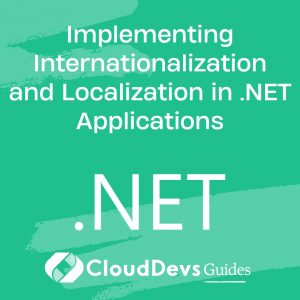Implementing Internationalization and Localization in .NET Applications
Table of Contents
In today’s globalized world, software applications must cater to users across different languages, cultures, and regions. This necessitates the implementation of internationalization (i18n) and localization (l10n) in software development. .NET, with its rich set of features and libraries, provides robust support for building globally accessible applications. This article explores how to implement i18n and l10n in .NET applications, complete with practical examples and best practices.

Understanding Internationalization and Localization
Internationalization (i18n) refers to the process of designing software in a way that it can be easily adapted to various languages and regions without requiring changes to the codebase. Localization (l10n) involves adapting the application to specific languages, cultures, or regions, often by translating text, adjusting date formats, and more.
Setting Up Internationalization in .NET
The first step in implementing i18n is to ensure that your .NET application is designed to support multiple languages and cultures. .NET provides a range of classes and methods to achieve this.
Example: Preparing Your .NET Application for i18n
You can start by enabling resource files in your application. These files will store the text and other localizable resources for each language.
```csharp
using System.Globalization;
using System.Threading;
using System.Windows.Forms;
class Program
{
static void Main()
{
// Set the culture to French (France)
Thread.CurrentThread.CurrentUICulture = new CultureInfo("fr-FR");
// Display a localized message
MessageBox.Show(Resources.HelloMessage);
}
}
```
In this example, the `Resources.HelloMessage` would be fetched from a `.resx` file containing the localized text.
Localizing Your .NET Application
Localization in .NET involves creating resource files for each language and culture that your application will support. Visual Studio simplifies this by allowing you to generate `.resx` files for different cultures.
Example: Creating and Using Resource Files
- Create Resource Files: Add a `.resx` file for each language (e.g., `Resources.en.resx`, `Resources.fr.resx`).
- Access Resources in Code: Access the localized strings in your application using the `ResourceManager` class.
```csharp
using System;
using System.Resources;
class Program
{
static void Main()
{
ResourceManager rm = new ResourceManager("YourNamespace.Resources", typeof(Program).Assembly);
// Get the localized string for the current UI culture
string localizedGreeting = rm.GetString("Greeting");
Console.WriteLine(localizedGreeting);
}
}
```
Handling Date, Time, and Number Formats
Beyond text, you’ll need to consider how dates, times, numbers, and currencies are displayed. .NET makes it easy to format these according to the user’s culture.
Example: Formatting Dates and Numbers
```csharp
using System;
using System.Globalization;
class Program
{
static void Main()
{
// Set the culture to German (Germany)
CultureInfo culture = new CultureInfo("de-DE");
// Format a date and a number
DateTime date = DateTime.Now;
double number = 1234.56;
Console.WriteLine(date.ToString(culture));
Console.WriteLine(number.ToString("C", culture));
}
}
```
Using Localization in ASP.NET Core
In ASP.NET Core applications, localization is managed through middleware and services that allow for dynamic localization based on the user’s culture.
Example: Setting Up Localization in ASP.NET Core
1. Configure Services in `Startup.cs:
```csharp
public void ConfigureServices(IServiceCollection services)
{
services.AddLocalization(options => options.ResourcesPath = "Resources");
services.AddControllersWithViews()
.AddViewLocalization()
.AddDataAnnotationsLocalization();
services.Configure<RequestLocalizationOptions>(options =>
{
var supportedCultures = new[] { "en-US", "fr-FR", "de-DE" };
options.SetDefaultCulture(supportedCultures[0])
.AddSupportedCultures(supportedCultures)
.AddSupportedUICultures(supportedCultures);
});
}
```
2. Use Localization in Views:
```html @inject IViewLocalizer Localizer <h1>@Localizer["WelcomeMessage"]</h1> ```
Testing and Maintaining Localization
Maintaining and testing your localized application is crucial for ensuring that all strings, formats, and cultural specifics are correctly implemented.
Tools for Testing:
– Pseudo-localization: Temporarily translating your app into an artificial language to test localization readiness.
– Globalization Testing Tools: Automated tools to check for localization and globalization issues.
Conclusion
Internationalization and localization are essential practices for making your .NET applications accessible to a global audience. By leveraging .NET’s robust support for i18n and l10n, you can create applications that meet the needs of users worldwide. Implementing these strategies effectively will enhance user experience and expand your application’s reach.



